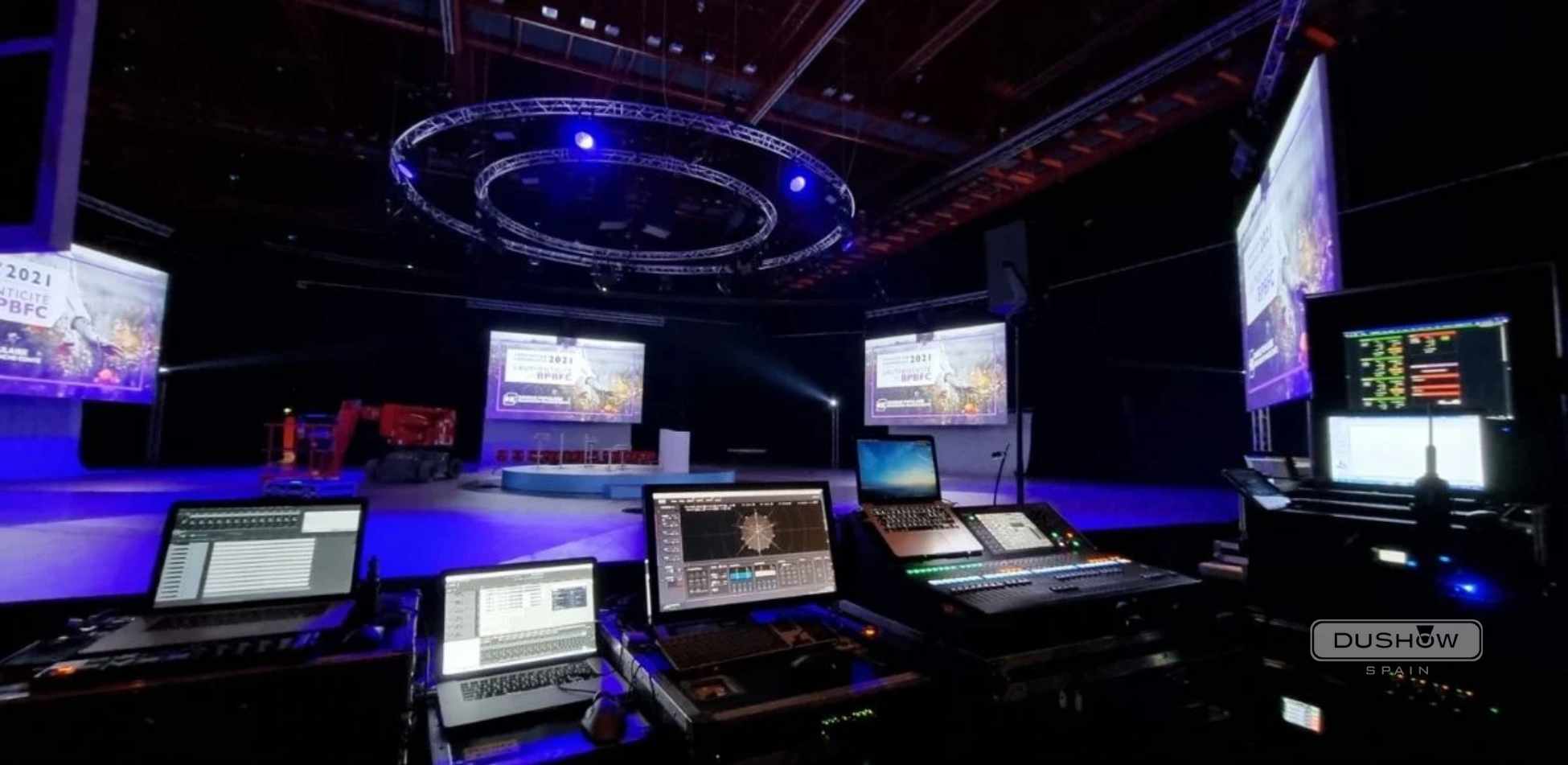Dushow Spain is now Novelty Spain
MASTERING AV Proposals FOR EVENTS:
UNCOVER 30 Essential Video Terms
Are you prepared to revolutionize your comprehension of audiovisual proposals? When it comes to assembling and reviewing audiovisual proposals for your events, understanding the jargon is paramount. No one wants unexpected surprises during their event, right?
In this post, we're delving into 30 essential video terms that will prove instrumental in demystifying audiovisual proposals. By getting familiar with these terms, you'll not only gain a deeper understanding but also enhance your ability to optimize the audiovisual proposals you work with. So, let's dive into the world of AV terminology and empower your event planning!
Empowering Your Event Planning
1. Aspect Ratio:
Unveiling the Proportions of Visual Brilliance
Imagine the scenario: your event is around the corner, your team and AV partner have meticulously crafted presentations with graphics, tables, and other visual elements, yet on the day, the projection doesn't quite fill the screen. There are empty spaces around the edges, and the presentation appears smaller than anticipated. What went wrong? The aspect ratios of the original material and the screen didn't align. Knowing the aspect ratio is paramount for maximizing visual impact at your event.
Imagine the scenario: your event is around the corner, your team and AV partner have meticulously crafted presentations with graphics, tables, and other visual elements, yet on the day, the projection doesn't quite fill the screen. There are empty spaces around the edges, and the presentation appears smaller than anticipated. What went wrong? The aspect ratios of the original material and the screen didn't align. Knowing the aspect ratio is paramount for maximizing visual impact at your event.
2. Bit Rate:
Decoding Data Velocity in Videos
Bit Rate, also known as Data Rate, determines how much data is transmitted per second in a video. This metric is expressed in kilobits per second (kbps) and plays a pivotal role in ensuring video quality and efficient transmission. Understanding Bit Rate is crucial for smooth video delivery.
3. B-Roll:
Enhancing Your Visual Storytelling
B-roll footage serves as the secret ingredient for seamless transitions and enriched storytelling in video editing. Whether you're producing news reports, wedding films, or interviews, B-roll enhances depth and visual interest. It's the storyteller's toolkit you've been missing.
4. Close Up:
Discover the Intimacy of Every Frame
Close-up shots in videos create intimate connections between viewers and subjects, allowing intricate details and emotions to shine. Perfect for highlighting critical moments and drawing audience attention.
5. Codec:
Your Guide to Digital Video Transformation
Codec, or Coder/Decoder, is the cornerstone of digital video transformation. Understanding codecs like Quicktime, MPEG4, H.264, and HEVC is crucial for efficient video compression and decompression, shaping the quality of your content.
Codec, or Coder/Decoder, is the cornerstone of digital video transformation. Understanding codecs like H264, HEVC (H265) and Apple ProRes is crucial for efficient video compression and decompression, shaping the quality of your content.
6. Colour Temperature:
Setting the Visual Mood
Colour temperature, measured in Kelvin, defines the mood and atmosphere of your video. Mastering colour temperature in video editing lets you evoke specific emotions and craft visually stunning effects.
7. Composite:
Merging Magic in Visuals
A composite in video refers to the merging of multiple visual elements into a single image on the screen. It is widely used in visual effects, combining separate elements to create a unified composition. Composites, also known as "comps," are essential in achieving seamless integration and enhancing the overall visual impact of a video.
8. Compression:
Streamlining Video Efficiency
Video compression is a crucial process that reduces file sizes by eliminating redundant data, allowing for faster upload, download, and storage. By optimizing bandwidth and maintaining video quality, it enables seamless streaming, efficient sharing, and widespread accessibility across various platforms and devices.
9. Cue Light:
Mastering Content Control
In video terms, the cue light, sometimes called a "traffic light," is the remote control equipment specifically used for content presentations.
The main trait that sets it apart from a standard clicker is that in most cases, the cue light is capable of controlling more than one computer at a time. With a cue light, users can activate or disable the control of each of the computers individually. They also make it possible to change the computers after every presentation, adding another layer of flexibility to manage contents.
If your speaker would rather not work the remote control themselves, it can be disabled from the computers. As the cue light has an integrated screen, the graphics operator can manually advance the content, whenever the cue light screen indicates that the presenter wishes to move ahead. Not just that, if your event has more than one presenter, or you’d simply like to configure a back-up system, different remote controls can be programmed.
The last major difference between the cue light and a normal clicker is that its radio-frequency is stronger. This means you can be further from the control center where the AV system operators are stationed.
10. Cut In:
The Art of Focusing on the Details
A cut in is a shot that focuses on objects or props being manipulated by the subject, providing a closer view of the interaction. Also referred to as an insert shot, it adds detail and emphasis to specific actions within the scene, complementing the main shots.
11. Fiber Optics:
Illuminating the Path to High-Speed Data
In the world of high-speed data transmission, fiber optics reign supreme. This technology sends information as pulses of light through glass or plastic fibers, enabling the transfer of large data bandwidth across vast distances. Fiber optics offers significant advantages over traditional copper cables, including greater bandwidth and faster transmission speeds.
There are two types of fiber:
- Single-mode fibers can transmit information over long distances, making them ideal for applications like Internet installations.
- In contrast, multimode fibers are suitable for shorter distances and are commonly used at events.
Additionally, fiber optics can be paired with various extenders, including HDMI, SDI, DVI, ethernet, and USB, making it a versatile solution for long-distance data transfer. Plus, the fusion of fiber optics and copper threads creates hybrid fiber, further expanding its applications.
12. Foley:
Crafting Realistic Soundscapes
Foley is the art of reproducing and creating sounds for film, including natural sounds and everyday actions that are not captured during filming but recreated in a studio environment. It adds depth and realism to the audio experience, enhancing the overall immersion of the audience.
13. Frame Rate:
Unraveling the Magic of Motion
Frame rate in video refers to the rate at which frames are captured, displayed, or scanned per second. It determines the smoothness and perception of motion in a video. Commonly expressed in frames per second (fps), examples include 24, 25, 29.97, 30, 50, and 60. A higher frame rate yields a more detailed and fluid image, providing editors with greater flexibility for manipulating footage's speed and timing. Frame rate plays a crucial role in capturing realistic motion and ensuring a visually appealing video experience.
14. Lower Thirds:
Adding Context with Style
Lower thirds are graphic overlays or titles that are placed in the lower portion of the screen to provide additional information, such as the name of a speaker or key details. They are widely used in news broadcasts, interviews, YouTube videos, and other forms of media to enhance visual communication and provide context to the audience. NewBlueFX offers a range of high-quality lower third titles through their titling plugins.
.png?width=960&height=540&name=NL%20BLOG%20+%20VIDEO%20(14).png)
15. Lumens:
Shedding Light on Projector Power
ANSI lumens represent the amount of light that a projector can generate. The bigger the projection screen, the bigger the projector you’ll need. You may also need a bigger projector depending on the amount of light in the room.
For example, a 10,000 ANSI lumen projector provides 1671 lux on a projection screen of 3 x 1.69 m. The same projector on a 4.5 x 2.53 m screen provides 742 lux. To get the same amount of lux on a screen of 4.5 x 2.53 m, you’ll have to change the projector to a model that produces 20,000 ANSI lumen, thus generating some 1580 lux.
In the same way, if you have 450 lux of general light in the room, the difference between ambient light and the projection with the 20,000 ANSI lumen projector will be some 1130 lux. Compared to the 10,000 ANSI lumen projector, there will be a difference of some 292 lux. What’s more, when you have a projector of 20,000 lumen, you not only have the advantage of a brighter screen, but also better contrast and image colour.
16. Media Server:
Your Gateway to Multimedia Mastery
The hardware or software (physical server or application programme) that supplies on-demand multimedia content is known as a media server. They are commonly used at professional live events such as concerts or in theatre.
It is a content player for large-format screens, or multiple smaller screens. These systems are usually scalable to the design needs of the audiovisual elements.
Media servers feature a deep and diverse tool box to configure how content is played. For example, video mapping and warping output. They can also interact with other components in the audiovisual installation, receiving and sending data. They can receive signals from infra-red cameras or button pads, and send signals to projectors or motors connected to parts of your scenography.
Some models have integrated video capture cards, enabling them to play or show content from external sources such as multi-camera systems. Media servers are widely used at live music events, such as concert tours.
17. Memory Bank:
Relive Moments, Preserve Memories
A memory bank is a video compilation that captures specific time periods or events in someone's life, serving as a digital archive of memories. It can incorporate natural sounds, be accompanied by music, document travel experiences, or simply record everyday moments, preserving them for future recollection and nostalgia.
18. Pixel Pitch:
The Pixels That Define Brilliance
Pixel pitch defines the distance between the centre of a pixel and the centre of the adjacent pixel on a LED screen. In general, screens with lower pitch have less space between pixels, and the pixels themselves are smaller. Therefore, more pixels fit in a module, and their density will be greater. A 3x2 metre LED screen with a pitch of 2.6 mm has more resolution than a screen of the same size and a pitch of 3.9 mm. There are some models that have two pixel pitch values, one for vertical and another for horizontal pitch
19. Pixel Aspect Ratio: Shaping Pixels for Perfection
Pixel Aspect Ratio (PAR) in video refers to the ratio between the width and height of individual pixels, influencing their shape and appearance within the image. Common examples include a 1:1 or 1.00 PAR for accurate display and compatibility.
20. Production Switcher:
Elevate Your Audiovisual Arsenal
A production switcher is a piece of hardware used to change or choose between different sources of audio or video. Although their main function is to select between audio and video sources, sometimes they are used to mix video, and add sequences or special effects in a secondary source. AV partners use production switchers in film and video production settings, such as production trucks and television studios, though they are also found among the audiovisual equipment for events.
Their operation is similar to that of audio mixers. They use multiple input sources, apply the desired effects and produce one or more outputs. Modern production switchers have additional characteristics such as the capacity to store complex mixer configurations.
21. Resolution: The Quest for Visual Detail
In video terms, resolution refers to the amount of detail that an image, monitor, or projection has. It describes the quality of any visual content.
It is expressed in pixels, DPI (dots per inch), or PPC (pixels per centimetre). The last two are unique numbers in video terms that stand for the quantity of pixels per inch or centimetre, also known as pixel density. For example, a 1920 x 1080 screen shows 1920 pixels horizontally and 1080 pixels vertically.
When comparing two screens of the same size but with different resolutions, the screen with the highest resolution (the one with the most pixels) will show more in video terms than what you are working on. Therefore, you won't have to move around as much.
As that screen has more pixels, the image it shows will be sharper. But remember, higher resolution also means that elements on the screen, such as icons and text, will appear smaller.
Nowadays, when it comes to screen resolution, there are more options than ever before. You can buy monitors that are high-definition (1366 x 768), full high definition (1920 x 1080), Wide Ultra Extended Graphics Array (1920 x 1200) and even ultra-high definition (3840 x 2160) or 4K.
It’s important to avoid the common mistake of only looking at the screen resolution, forgetting about what counts most: your screen’s resolution only matters if your content is at the same level. A 1080p screen won’t make a low-resolution picture or video suddenly become high-definition. If you want to achieve the best quality for your event, the quality of your source or stock content is the place to begin
22. Shot List:
Your Blueprint for Captivating Videos
A shot list in video production serves as a comprehensive checklist of planned shots, ensuring efficiency and direction in the filmmaking process. It helps videographers save time and money by organizing the desired shots in advance and avoiding editing rule violations. By including minute details, the short list enhances the overall flow and purpose of the film, enabling a more focused and streamlined production.
23. Storyboard:
Visualize Your Creative Vision
A storyboard is a series of illustrations that visually depict each scene of a film or video production, serving as a blueprint for the project. It offers a structured and organized way to visualize and plan the shots or animations required for the production. By providing a clear and concise visual plan, storyboards help filmmakers effectively communicate their creative vision and ensure a smooth execution of the project.
24. Sync:
Harmonizing Sound and Vision
Sync in video refers to the alignment of audio and video elements, ensuring that the sound is properly synchronized with the corresponding visuals.
25. Synoptic:
Navigating the Video Wiring Maze
The term “synoptic” refers to a schematic image of the flow of signals and the relationship between the elements in a video like sound, lighting or electrical power installation. In other words, it’s like a road map, but one that shows types of wiring and signals.
26. Three-Point Lighting:
Illuminate Your Scene Like a Pro
Three-point lighting is a versatile and widely used lighting setup in video production. It involves the strategic placement of three lights: the key light, which provides the primary illumination and highlights the subject; the fill light, used to soften shadows and balance the overall lighting; and the backlight, placed behind the subject to create separation and depth. This technique helps control shadows, add dimensionality, and enhance the visual quality of the scene, resulting in a professional and visually appealing video.
27. Tilts: Capturing Unique Perspectives
Tilts are camera movements that involve fixed vertical motions, either upward or downward, capturing a different perspective. They are the opposite of pans and add visual interest and variety to video shots.
28. White Balance:
True Colours, No Compromises
White balance is the adjustment made to ensure accurate and natural colours in a video by compensating for the colour temperature of the light source. It ensures that white appears as true white without any colour casts, such as yellow or blue tints. Cameras often provide a white balance menu and auto white balance feature to achieve optimal colour accuracy in different lighting conditions.
29. Wide Angle:
Unlock New Dimensions of Creativity
A wide-angle lens is designed with a shorter focal length than standard lenses, allowing it to capture a wider field of view from the same distance. It includes more of the subject in the frame compared to a normal lens of similar size. However, it's important to note that wide-angle lenses can introduce distortion, potentially warping the appearance of the subject in filmmaking. In addition, a wide angle can also add vignetting. This is an effect that darkens the perimeter of the image and can be undesired.
30. 4K:
A Resolution Revolution
The "K" in 4K, in video terms, stands for kilo (1000). Therefore, this video term specifically refers to screens that achieve a horizontal resolution of approximately 4,000 pixels. It’s a type of resolution also known as Ultra High Definition (UHD = 3840x2160).
.png?width=960&height=540&name=NL%20BLOG%20+%20VIDEO%20(7).png)
4K screens have four times as many pixels as traditional Full HD screens (1920 x 1080). Even in TV screens of the same size, 4K TV image quality ends up being more vivid and detailed thanks to a greater pixel density. This difference is especially obvious when it comes to large screens.
Also, this resolution often goes hand in hand with HDR if we are talking about TV Screens. The colour gamut they can reproduce is a lot wide. To be able to reproduce this gamut these displays give more light compared to the SDR ones. Also the bit depth is higher. SDR typically 8 bit compared to HDR 10 bit. These 2 bits of difference has a huge impact, from the reproduction of 16,7 million coulors on SDR to 1.07 billion on HDR 10 bit.
Master Your AV Universe
You've embarked on a journey into the world of audiovisual terminology, arming yourself with the knowledge to enhance your event planning and presentations. But why stop there? Your next step is to take action and put this newfound expertise to use.
Ready to Transform Your Events?
Don't miss out on the opportunity to turn your vision into reality. Reach out to our AV experts and let's craft unforgettable events together. Your journey to audiovisual excellence begins now!
#AVTerminologyMastery #ElevateYourEvents #ContactUsToday







